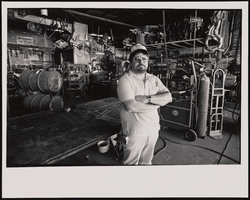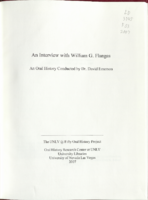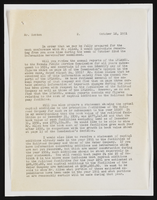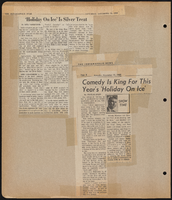Search the Special Collections and Archives Portal
Search Results

Transcript of interview with Craig Palacios by Stefani Evans and Claytee White, September 27, 2016
Date
Archival Collection
Description
Craig Palacios was born on November 1, 1971 and grew up in the Paradise Palms neighborhood in Las Vegas, Nevada. His family lived close to him and he remembers playing with his relatives up and down the Maryland Parkway Corridor. His first job was in construction where he poured and finished concrete. His talents for design became apparent and he began a new job as a swimming pool designer. Craig’s first company was a concrete company, but he later had to close its doors. After that, Craig decided to attend college and graduated with degrees in Architecture and Art History from UNLV in 2005. He worked for YWS Architecture for a few years before opening his own studio in 2011. Since then, BunnyFish Studio has worked on the Downtown Project and the Maryland Parkway Project.
Text
Jennie Mead oral history interview
Identifier
Abstract
Oral history interview with Jennie Mead on March 04, 1978 for the Ralph Roske Oral History Project on Early Las Vegas. In this interview, Mead discusses her career as a waitress at the Hacienda Hotel and Casino in Las Vegas, Nevada, where she had worked for twenty-one years at the time of the interview. Mead also describes how the Hacienda Hotel and Casino had changed over the years.
Archival Collection

Transcript of interview with Charles and Anne Snavely by Lois Goodall, February 5, 2014 and January 8, 2015
Date
Archival Collection
Description
S. Charles Snavely, a long-time Las Vegas pediatrician, arrived in Nevada in 1965 with his wife, Ann, and two children courtesy of the United States Air Force. The family lived at Nellis Air Force Base while Charlie completed his Barry Plan commitment to the military. In separate interviews, Charlie and Ann discuss their arrival in Las Vegas, their first house in the Glen Heather area of Ward 1, and their current house in the Scotch 80s (pictured above). Charlie and Ann met at a small private hospital in Lebanon, Pennsylvania, where Ann was working as a nurse. The two University of Pennsylvania graduates, now married 63 years, raised their children in their Scotch 80s house and so far have not been tempted to move elsewhere.
Text

Henry Sanchez, owner-operator of Diamond Metal Works sheetmetal fabrication and welding shop, stands inside his Las Vegas, Nevada business: photographic print
Date
Archival Collection
Description
In business since 1980, Henry Sanchez, owner-operator of Diamond Metal Works, a sheetmetal fabrications and welding shop, is reflective of many young Hispanics who each year are starting their own businesses. Born in Cheyenne, Wyoming, Sanchez graduated from Basic High School in Henderson and served his 4-year apprenticeship with Sheetmetal Local 88 in Las Vegas.
Image

Transcript of interview with William G. Flangas by Dr. David Emerson, September 27, 2006
Date
Archival Collection
Description
Text





